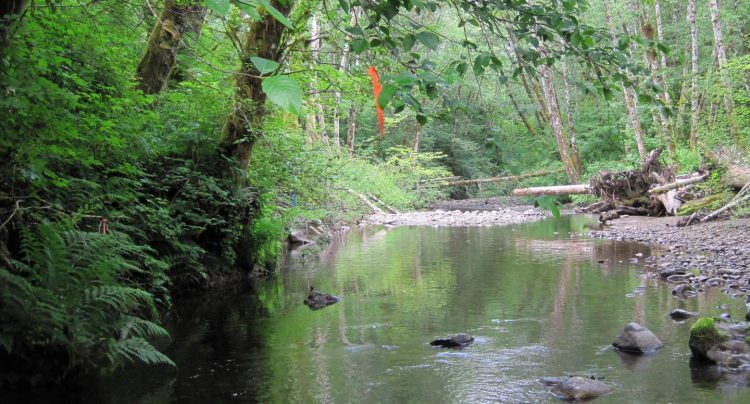Plants' defensive responses have downstream effects on nearby ecosystems

This is a typical river reach on the Merrill & Ring Tree Farm, Olympic Peninsula, Washington. Credit: Sara Jackrel
Graduate student Sara Jackrel and Timothy Wootton, PhD, professor in the Department of Ecology and Evolution, simulated herbivory, or the activity of insects eating leaves, on red alder trees in a forest on the Olympic Peninsula in Washington state.
Their research showed caterpillars ate fewer leaves from the stressed trees than those that were left alone. Leaves from these stressed trees also decomposed much more slowly when submerged in nearby streams, and further results suggest that the trees funneled a valuable nutritional resource away from the leaves as a defensive response to animal attacks.
“Terrestrial herbivory could have innumerable effects on leaf chemistry, and our simulation had a very strong effect in streams,” said Jackrel, the study's lead author. “The tree's response to herbivory had a cascading effect across an ecosystem boundary, into another trophic level entirely. The important finding was making that indirect link from a terrestrial system into an aquatic system.”
Plants generate many defensive responses to being attacked by insects and other animals. Some produce tannins and compounds that are toxic or taste bad to discourage herbivores from eating them. Others may even release chemicals that attract predators for the particular insect attacking the plant.
Insects and microbe decomposers that live in streams depend on a variety of nutritionally diverse leaf litter as a food sources. They play no direct role in the interactions between trees and their herbivores, but the new study shows how the composition of those leaves is shaped by their activity,
During her fieldwork, Jackrel mimicked the activity of caterpillars by systematically punching holes in the alder leaves with an office hole punch. She also painted the leaves with methyl jasmonate, a chemical that trees release under stress, to enhance the defensive response to the hole punches. Some trees were fertilized with phosphorus, while others were not.
Jackrel then buried packages of leaves and placed others underwater in a stream to test how quickly they decomposed in both soil and water. Caterpillars were also allowed to feed on treated and untreated leaves to test their preferences.
Leaves from trees that received both fertilizer and the herbivory treatment decomposed the most slowly. Caterpillars and aquatic insects ate fewer of these leaves than those from untreated trees as well.
Nitrogen levels were also much lower in the treated leaves. Insects value nitrogen as a nutrient, and the study results suggest that trees alter nitrogen levels to deter them from eating more leaves, perhaps by storing it the trunk or roots.
Understanding how trees' defensive responses to natural herbivores impact nearby streams will help scientists better predict the effects of climate change and other human activity like logging and agriculture.
“With climate change, insect communities are going to change,” Jackrel said. “So understanding fundamentally how these communities naturally affect leaf chemistry, and how that might affect stream systems, is a critical reference to have. Then we can work to predict how climate change, along with other anthropogenic changes, might be affecting aquatic systems.”
###
The study, “Cascading effects of induced terrestrial plant defences on aquatic and terrestrial ecosystem function,” was supported by the National Science Foundation, the U.S. Department of Education, the University of Chicago Hinds Fund and an Olympic National Resources grant.
About the University of Chicago Medicine
The University of Chicago Medicine & Biological Sciences is one of the nation's leading academic medical institutions. It comprises the Pritzker School of Medicine, a top 10 medical school in the nation; the University of Chicago Biomedical Sciences Division; and the University of Chicago Medical Center, which recently opened the Center for Care and Discovery, a $700 million specialty medical facility. Twelve Nobel Prize winners in physiology or medicine have been affiliated with the University of Chicago Medicine.
Visit our research blog at sciencelife.uchospitals.edu and our newsroom at uchospitals.edu/news.
Twitter @UChicagoMed
Media Contact
All latest news from the category: Life Sciences and Chemistry
Articles and reports from the Life Sciences and chemistry area deal with applied and basic research into modern biology, chemistry and human medicine.
Valuable information can be found on a range of life sciences fields including bacteriology, biochemistry, bionics, bioinformatics, biophysics, biotechnology, genetics, geobotany, human biology, marine biology, microbiology, molecular biology, cellular biology, zoology, bioinorganic chemistry, microchemistry and environmental chemistry.
Newest articles

A ‘language’ for ML models to predict nanopore properties
A large number of 2D materials like graphene can have nanopores – small holes formed by missing atoms through which foreign substances can pass. The properties of these nanopores dictate many…

Clinically validated, wearable ultrasound patch
… for continuous blood pressure monitoring. A team of researchers at the University of California San Diego has developed a new and improved wearable ultrasound patch for continuous and noninvasive…

A new puzzle piece for string theory research
Dr. Ksenia Fedosova from the Cluster of Excellence Mathematics Münster, along with an international research team, has proven a conjecture in string theory that physicists had proposed regarding certain equations….



